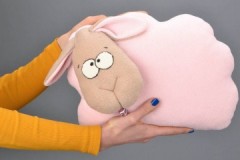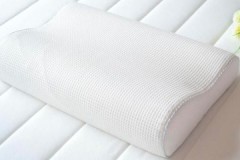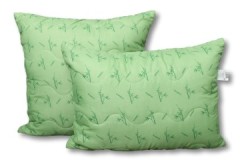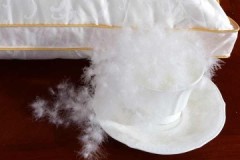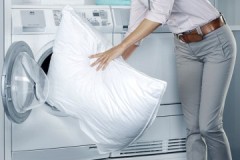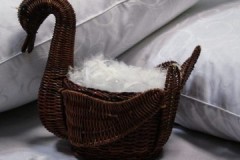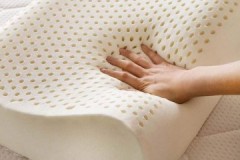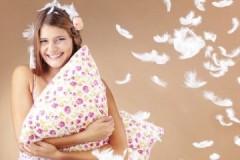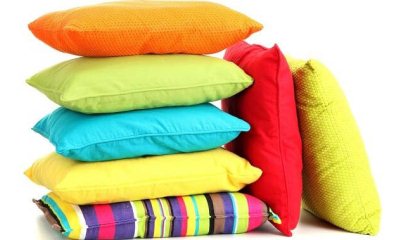 All household items that a person uses regularly need cleaning from time to time. This is especially true for bedding, because a person spends almost half of his life in bed.
All household items that a person uses regularly need cleaning from time to time. This is especially true for bedding, because a person spends almost half of his life in bed.
Close contact with the pillow allows its filler to absorb sweat, skin particles, and cosmetic residues. Gradually, this bedding attribute turns into a breeding ground for microorganisms and a reservoir of dust.
A radical method - washing - will help to save healthy sleep and good health. But how to properly wash a pillow at home, in what mode, at what temperature?
Content
Is it washable?
 This question has been asked by many housewives. The answer options depend on the type of filler.
This question has been asked by many housewives. The answer options depend on the type of filler.
The primary source of information will be the product label, which indicates not only the composition of the filler, but also methods of care.
Fillers are conventionally divided into two types:
- natural (down, feather, wool, buckwheat husk, silk, bamboo);
- synthetic (holofiber, polyester, padding polyester, latex).
Bedding made from synthetic padding polyester and holofiber are considered the most trouble-free to wash.
Most fillings can be machine washed, adhering to certain recommendations on the following points:
- temperature limits;
- exposure mode;
- choice of detergents;
- drying algorithm.
Washing by hand is a painstaking process, but more gentle.. The advantages include the ability to visually evaluate the washing results.
It is easier to wash bulky items that are difficult to fit into the drum of a washing machine by hand.
You can find out how to wash other bedding here.
How to properly wash at home?
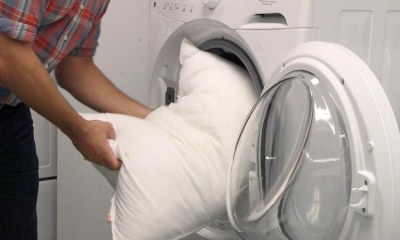 At home, washing pillows will not cause much difficulty. Machine washing and hand washing have a number of common actions, thanks to which a positive cleaning result is guaranteed.
At home, washing pillows will not cause much difficulty. Machine washing and hand washing have a number of common actions, thanks to which a positive cleaning result is guaranteed.
The cleaning process begins with knocking out dust. For this purpose, you can use a carpet flapper. This procedure should be carried out in the fresh air.
Before you start washing, you need to make sure that there are no holes in the bedsheet; any holes should be sewn up.
Wash pillows either as a whole, without ripping the pillowcase, or in parts, using special bags. To a greater extent, this applies to products made from waterfowl feathers, where the amount of filler is quite large, which makes quality cleaning and proper drying difficult.
An equally important point is the choice of detergent. Liquid gels are used for washing. There are household chemicals specially designed, taking into account the specific characteristics of the filler.
Washing temperatures must be strictly controlled. From thirty to forty degrees Celsius is the optimal range for various fillers, which will preserve their integrity.
When washing any type of pillow content, an additional rinse is required. This removes any remaining detergent.
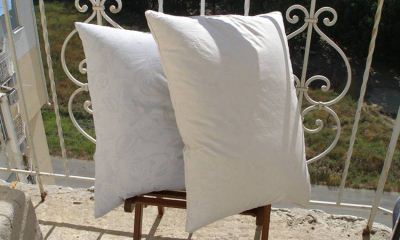 When squeezing the product, you should refrain from aggressive twisting material or the use of high speeds, the filler reacts to this by forming lumps and changing its shape and structure.
When squeezing the product, you should refrain from aggressive twisting material or the use of high speeds, the filler reacts to this by forming lumps and changing its shape and structure.
Such bedding items are dried horizontally on a flat surface or vertically on a clothesline, secured with clothespins. During the process, the pillows are shaken periodically to straighten the filling.
Do not dry the filler over an open fire or on heating devices.. The ideal option is natural drying in the fresh air.
In the washing machine
Unlike hand washing, the items do not need to be pre-soaked. An exception is made if the filler is heavily soiled.
The algorithm of actions is as follows:
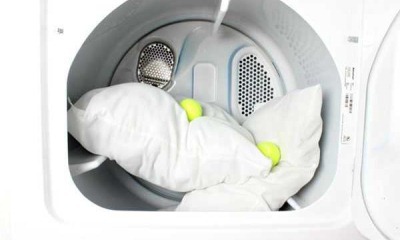 place the pillow or bags with parts of the filler inside the drum;
place the pillow or bags with parts of the filler inside the drum;- put four laundry balls or tennis balls there;
- select a gentle washing mode – “delicate”, “quick wash”, “wool”;
- check the set water heating temperature;
- set the push-up speed to no more than four hundred;
- turn on additional rinsing;
- use gel capsules or liquid detergents;
- after the end of the cycle, take out the product and shake it several times;
- dry thoroughly.
Handwash
Washing by hand includes several successive steps:
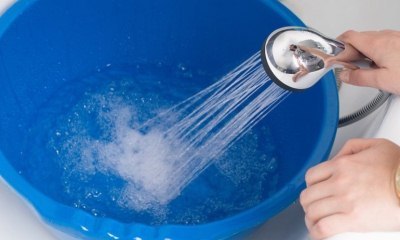 dissolve detergent in warm water;
dissolve detergent in warm water;- immerse the pillow or filler in water;
- leave for one hour;
- clean the product with gentle movements, lightly squeezing and pressing;
- change the water, rinse - repeat this procedure twice;
- squeeze out;
- dry.
The filling of a feather pillow can be washed by hand using special covers or without them - opening the pillowcase and pouring the contents into water.
Nuances of the procedure for natural fillers
There are two subtypes of natural filler:
- vegetable origin (buckwheat husk, bamboo);
- animal origin (wool, fluff, feathers).
Each of them dictates its own conditions, compliance with which will not only allow for high-quality cleaning of the product, but also maintain its integrity.
Made from camel hair
 This type of filler is obtained from the soft undercoat of camels. The product is lightweight and elastic. The service life is about seven years.
This type of filler is obtained from the soft undercoat of camels. The product is lightweight and elastic. The service life is about seven years.
For this type of filler Preferably hand wash with soaking for up to twenty minutes. If washing in a machine, it is better to disable the spin function.
When squeezing the product with your hands, under no circumstances should you twist it. This will cause deformation of the wool fibers.
Made from sheep's wool
The filler is made from a special breed of sheep - merino.. The material is soft and hygroscopic. The price is quite affordable. The pillow can be used for five years.
From buckwheat husk
 It would seem that this is a non-standard filler option, but it has found its adherents. Products made from buckwheat husks have a massage effect and improve blood circulation.
It would seem that this is a non-standard filler option, but it has found its adherents. Products made from buckwheat husks have a massage effect and improve blood circulation.
The disadvantages include the considerable weight for such an attribute - up to five kilograms, rustling of the husk at the slightest movement, useful life less than three years.
This natural filler cannot be washed categorically. The husks swell under the influence of water, dry poorly, and leave brown stains on the bedsheet.
The best way to care for this filler is periodic sifting of husks, dry cleaning with a vacuum cleaner.
Made from fluff
The filling of such a pillow consists of down and small feathers in equal proportions. This makes the product weightless and very soft.
Such products can be washed either by machine or by hand.. Due to the large volume of the filler, it is distributed into bags and carefully sewn up. When washing by hand, it is allowed to pour the filler directly into the water, without using covers. In this case, special attention should be paid to the absence of drafts in the room.
For more detailed recommendations on caring for such bedding attributes, read Here.
Feather
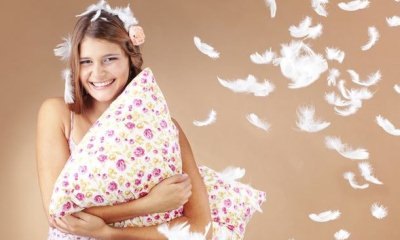 The main difference from down feathers is the percentage of feather to down.. Most often it is eighty to twenty percent.
The main difference from down feathers is the percentage of feather to down.. Most often it is eighty to twenty percent.
Chicken feather pillows are not washable. They are cleaned using the dry method. But products made from waterfowl feathers easily withstand the effects of water.
As is the case with down bedding, The filling can be washed both in a machine and by hand. Machine washable requires the use of covers. When washing by hand, you can use bags, or you can rip the diaper and place the contents in a container with water.
You can learn various secrets and tips on this topic by reading this article.
Made from swan's down
A pillow made of swan down is quite an expensive pleasure. However, the costs will be offset by the undoubted advantages of such a natural filler:
- durability,
- comfort,
- ability to quickly restore shape.
Accurate and complete information on the issue of care is provided Here.
Bamboo
 The name sounds incredible, but behind it lies a delicate fiber obtained from durable bamboo stems. This is an environmentally friendly, hypoallergenic, antibacterial filler.
The name sounds incredible, but behind it lies a delicate fiber obtained from durable bamboo stems. This is an environmentally friendly, hypoallergenic, antibacterial filler.
You can wash it once every six months in a machine or by hand. When choosing a cleaning mechanism, you should consider the size. Bulk items will not fit into the drum of the washing machine.
When machine washing, use special balls. You need to squeeze it out carefully so as not to damage the fibers of the filler. Dry on a lattice horizontal surface, shaking occasionally.
The most reliable information on washing bamboo filler is presented in this article.
What are the features for artificial fillers?
Technical progress introduces new types of fillers that are in no way inferior, and in some ways superior, to natural ones.
Foam rubber
 It should be remembered that foam rubber consists of foam, which forms numerous cells filled with air.
It should be remembered that foam rubber consists of foam, which forms numerous cells filled with air.
It is this factor that causes the fragility and tendency of this material to deform.
Foam can be exposed to water. Bend, crumple, twist - you can’t. Therefore, large foam products can only be washed by hand.
Forty degrees Celsius is the maximum temperature for water. Bleach is prohibited. This material is pressed out by pressing.
Made from polyester
Synthetic material, soft, lightweight. Does not attract dust, does not cause allergies. Service life is about four years. The disadvantages include the fact that during operation it tends to cake, decreasing in volume.
"Antistress"
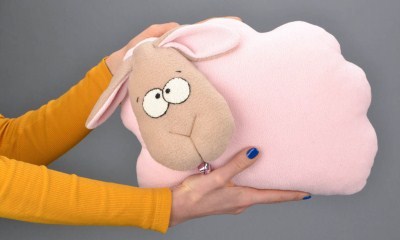 This miracle of scientific thought will help relieve stress after a tiring day. Small polystyrene beads are used as filler for such products..
This miracle of scientific thought will help relieve stress after a tiring day. Small polystyrene beads are used as filler for such products..
They create a relaxing effect and have moisture-repellent properties. The latter allows you to easily wash pillows of this type.
To avoid “leakage” of the filler during water procedures, you should carefully check the integrity of the fabric of the diaper or cover.
Washing features are presented in the following article.
Made from holofiber
Unlike polyester, holofiber is more wear-resistant. It keeps its shape perfectly, does not absorb odors, and does not create conditions for the proliferation of microorganisms.
You can get a lot of useful information on the topic Here.
From padding polyester
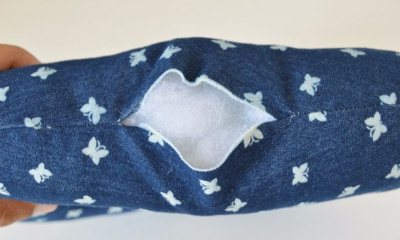 Sintepon pillows are quite popular. They are resilient, comfortable and cheap. Hand and machine washing, subject to certain rules, will not be a problem.
Sintepon pillows are quite popular. They are resilient, comfortable and cheap. Hand and machine washing, subject to certain rules, will not be a problem.
A special feature of care is that the synthetic winterizer does not need to be soaked. Prolonged contact with water is undesirable. Be sure to rinse the product well. Drying in a washing machine is prohibited.
Interesting facts, manufacturers' instructions are described in this article..
Latex
The porous structure of this material allows moisture to evaporate without absorbing it. The guaranteed service life is ten years.
A large number of important recommendations are set out in the relevant article.
Orthopedic
 A certain type of orthopedic pillow filler is a determining factor in the care of the product.
A certain type of orthopedic pillow filler is a determining factor in the care of the product.
For example, memory foam bedding should not be washed. The most complete information is indicated on the manufacturer's label.
The article shares indispensable tips and little tricks “How to wash an orthopedic pillow”.
Maternity pillows
Pillows for expectant mothers mainly use synthetic fillers: holofiber, polystyrene.
They are safe for health and, despite their unusual shape, the principles of caring for them correspond to the type of filler, as in ordinary pillows.
Immediately after purchase, you should wash the pillowcase of the new product and beat the filling thoroughly. You can wash it when it gets dirty, but not more than four times a year.
Conclusion
Awareness of the features of various fillers will greatly simplify the care process.. Proper washing of a pillow at home will not only clean the product, extending its service life, but will also save money and sound sleep for the owner.
